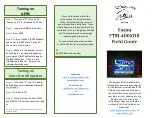
RSS-2-300W User Manual
11
RSS-2-300W Non-Contact Surface Velocity Radar
Device ID
Device ID
- Configures the device (slave) ID to be used on RS-485 interface protocols (Modbus
RTU or HS). Both protocols use request/response format and allow multiple instruments to
be connected on the same bus. When a remote master transmits the request message, it will
use the device ID as a device address. All instruments will receive the request, but only the
instrument with matching device ID will answer to the received request.
Modbus Settings
Modbus settings
- Configures the parity and number of stop bits used in communication.
Parity is used in serial communication for basic error detection. When parity is set to none, no
parity is used, and no error detection is possible on bit level. When parity is set to odd parity,
an additional bit is added to the communication that will be set to 1 when there is odd number
of bits with value 1 in the 8-bit payload byte. Similarly, when parity is set to even parity, an
additional bit is added to the communication that will be set to 1 when there is even number of
bits with value 1 in the 8-bit payload byte. In general, all bytes on the receiver side where the
parity bit is not matching the message will be discarded. Default setting on most devices that
use Modbus is even parity. Stop bits are added to the end of each data byte transferred over
serial communication, to allow pause between two bytes. The default setting is even parity and
one stop bit.
Warm Up Time
Warm up time
- The time after sensor power-up, during which all measurements are ignored.
This time is used to settle auto-gain parameters, Kalman filter values, averaging filter, and all
other operational parameters. It is recommended to set this value to a minimum of 5 seconds. In
extreme cases where a quick response after unit power-up is required, 3 seconds can be used, with
a possibility of losing measurement accuracy.
ID
ID+1
ID
Device ID
WARM UP TIME
POWER ON
Dead time















































